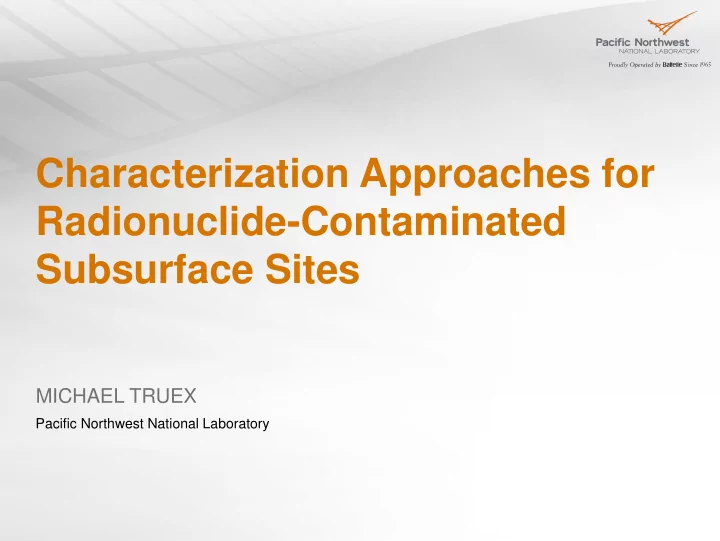

Characterization Approaches for Radionuclide-Contaminated Radionuclide Contaminated Subsurface Sites MICHAEL TRUEX Pacific Northwest National Laboratory
Outline Conceptual model framework Characterization for factors controlling fate and transport Characterization for factors controlling fate and transport and remedy selection Vadose Zone Disposal chemistry affects Transport factors Groundwater Groundwater Speciation and biogeochemistry Secondary sources Groundwater dynamics Natural attenuation processes Conclusions Conclusions 2
Conceptual Model Framework Plume System Surface Source Vadose Vadose Plume Segment 2 Plume Segment 2 Source Plume Segment 1 Truex et al. 2011 3
Conceptual Model Framework Segment 2 g - Low redox Segment 1 - High CEC (lenses) - High redox - Fe rich sand - High CEC (lenses) Truex et al. 2011 4
Vadose Zone Elements Disposal Chemistry Disposal Chemistry Co-contaminants and other characteristics of the disposed waste may impact transport for the contaminant of interest. These effects may be most intense near the disposal ff location (vadose zone). Transport Factors p For surface waste disposal, transport of contaminants through the vadose zone affects the nature of the source to groundwater groundwater. 5
Disposal Chemistry Szecsody et al. 2013 6 Truex et al. 2014
Disposal Chemistry Interpreted uranium Hypothesized targeted mobility of extracted Color Extraction Solution sediment components fraction Code 1. Aqueous: Uranium in pore water Mobile phase uncontaminated and a portion of sorbed Hanford uranium groundwater 2. Ion Exch.: Readily desorbed Readily mobile through 1M Mg-nitrate uranium equilibrium partitioning 3. Acetate pH5: Uranium associated with Moderately mobile 1 hour in pH 5 surface exposed through rapid dissolution sodium acetate carbonate precipitates, processes solution including uranium carbonates, or other readily dissolved precipitates 4. Acetate pH 2.3: Dissolution of most Slow dissolution 1 week in pH 2.3 carbonate compounds, processes are associated acetic acid including uranium with uranium release carbonates, and sodium from this fraction such boltwoodite that uranium mobility is low with respect to impacting groundwater 5. 8M HNO 3 : 2 hours Dissolution of most Very slow dissolution in 8M nitric acid at minerals expected to processes are associated 95 o C o contain uranium, with uranium release considered to represent from this fraction such Szecsody et al. total uranium extraction that uranium mobility is for this study 1 2010, 2012 very low with respect to 7 impacting groundwater
Disposal Chemistry Serne et al. 2010 8 Szecsody et al. 2010
Evaluation of VZ Transport There are characteristic behaviors that are useful in assessing the nature of contaminant transport from assessing the nature of contaminant transport from aqueous waste disposal/leaks to the vadose zone. There are two primary categories of transport behavior Category I: small volume disposed compared to vadose zone thickness Category II: large volume disposed compared to vadose Category II: large volume disposed compared to vadose zone thickness 9
Category I g y Category II g y 6 5 10 m charge (1/yr) 4 25 m 3 Solute Disc 2 1 0 0 500 1000 1500 Time (years) Truex et al. 2015a 10
Analysis/Characterization Framework Vadose Zone Groundwater Parameters Waste Disposal Parameters Parameters Groundwater Darcy L L V V Thickness ( Thickness ( ) ) Aqueous volume ( Aqueous volume ( ) ) v wd d q flux ( ) a Recharge rate (historical, current, Contaminant mixing thickness M Disposed mass ( ) wd and estimated future rates) ( R ) L in aquifer ( ) a Monitoring well screen length n R Porosity ( ) Rate of waste disposal ( ) v wd for compliance ( s ) o co p a ce ( s ) Contaminant retardation C n Contaminant concentration ( ) Porosity ( ) wd a R coefficient ( ) cv Current vertical distribution of Surface area of aqueous disposal ( SA wd ) Contaminant retardation contamination R coefficient ( ) ca Acidity or alkalinity of the waste Acidity or alkalinity of the waste θ θ M i Moisture content profile ( fil ( ) ) v Ionic strength and co- contaminants/species in the waste Truex et al. 2015a 11 Timing of waste disposal
Evaluation of VZ Transport Contaminant Distribution Characterization Tools Geophysical logging Geophysical logging Spectral gamma log Neutron moisture log Borehole sediment samples Borehole sediment samples Geophysics Electrical Resistivity Tomography 12 Johnson and Wellman 2013
Groundwater Elements Speciation and biogeochemistry Characterization of a plume as 129 I can be augmented with Characterization of a plume as 129 I can be augmented with speciation information to provide insight into mobility Iodide and iodate have different transport characteristics Xu et al. 2015 Truex et al. 2015b 13
Groundwater Elements Secondary sources (leaching) Uranium sources related to periodic rewetting and leaching Uranium sources related to periodic rewetting and leaching Peterson et al. 2008 14
Groundwater Elements Secondary sources (leaching) Uranium sources related to periodic rewetting and leaching Uranium sources related to periodic rewetting and leaching Relevant for other inorganic contaminants (e.g., I, Cr) Example Sediment Example Sediment Szecsody et al. 2010, 2012 15
Groundwater Elements Groundwater dynamics Hydrologic information can be augmented with geophysical Hydrologic information can be augmented with geophysical techniques such as Electrical Resistivity Tomography Peterson and Connelly 2001 16
Groundwater Elements Groundwater dynamics Hydrologic information can be augmented with geophysical Hydrologic information can be augmented with geophysical techniques such as Electrical Resistivity Tomography Johnson et al. 2015 Slater et al. 2010 17
Groundwater Elements Natural attenuation processes EPA MNA Technical Protocol “Scenarios” conceptual model document Sediment biogeochemical factors Sediment biogeochemical factors M Monitoring data it i d t Temporal data provides insights not possible with static data Natural or induced perturbations aid the interpretation of temporal data 18
Conclusions Conceptual model framework Technical basis and organization of efforts Communication Assess controlling factors Assess controlling factors Fate and transport assessment Technical focus Characterization Monitoring Remediation Remediation 19
Recommend
More recommend